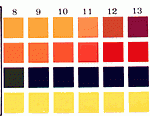The dictionary defines pH as "A measure of the acidity or alkalinity of a solution calculated as the common logarithm of the reciprocal of the hydrogen ion concentration in moles per cubic decimeter of solution and numerically equal to 7 for neutral solutions. pH increases with increasing alkalinity and decreases with increasing acidity. [potential of hydrogen.]"
Acids and bases are opposites, on the opposite ends of the pH scale. The more acidic or basic a solution is, the further out on the scale it will be. Seven is the central point. The number '1' reflects the strongest acid and a '14' represents the strongest base. Mix a strong acid and a strong base together and you'd get a huge explosion. In fact, mixing acids and bases were some of the first rocket fuels.
You must have a base, or caustic solution to make soap. The two most common caustic solutions in use for soap making today are sodium hydroxide (lye)[NaOH] and potassium hydroxide [KOH].
You can test the strength of an acid or base by using 'litmus paper.' This is a special paper with chemicals in it that change the paper's color to many different shades depending on it's pH.
To test a bar of soap's pH, wet the bar in running water and rub the bar with your hands until you get some bubbles or a thin film of liquid soap on the outside of the bar. Wet your litmus paper on it and check the reading. Really, it's just that easy. It's fun to test your soap throughout it's curing process to observe how the pH drops over time. Your finished soap will be alkaline to some degree, however it should not be above a pH of 10. Nine or less would be better. If your soap's above a pH of 10 it's likely to cause a burning sensation on your skin, starting with the more sensitive skin on your body. Over lots of time a soaps pH tends to drop. Soap that is lye heavy may need to be saved for laundry soap.
[caption id="attachment_531" align="aligncenter" width="150"] scale used to test ph[/caption]
Most pH strips, as they are sometimes called, are a single paper. Many use a more accurate pH strip that actually has four small sections of different kinds of litmus paper glued to a plastic strip. It's much more accurate than regular litmus paper and more convenient.
This picture shows the scale you'd use to match your test strip with in determining the pH. Check to see which set of colors most closely match your strip. The number at the top tells what the pH is.
scale used to test ph[/caption]
Most pH strips, as they are sometimes called, are a single paper. Many use a more accurate pH strip that actually has four small sections of different kinds of litmus paper glued to a plastic strip. It's much more accurate than regular litmus paper and more convenient.
This picture shows the scale you'd use to match your test strip with in determining the pH. Check to see which set of colors most closely match your strip. The number at the top tells what the pH is.
 scale used to test ph[/caption]
Most pH strips, as they are sometimes called, are a single paper. Many use a more accurate pH strip that actually has four small sections of different kinds of litmus paper glued to a plastic strip. It's much more accurate than regular litmus paper and more convenient.
This picture shows the scale you'd use to match your test strip with in determining the pH. Check to see which set of colors most closely match your strip. The number at the top tells what the pH is.
scale used to test ph[/caption]
Most pH strips, as they are sometimes called, are a single paper. Many use a more accurate pH strip that actually has four small sections of different kinds of litmus paper glued to a plastic strip. It's much more accurate than regular litmus paper and more convenient.
This picture shows the scale you'd use to match your test strip with in determining the pH. Check to see which set of colors most closely match your strip. The number at the top tells what the pH is.
